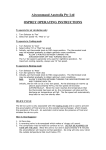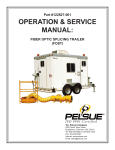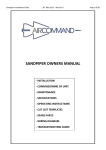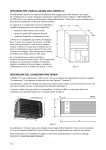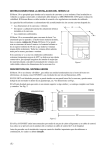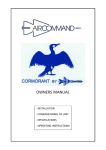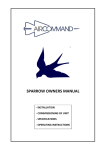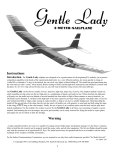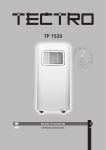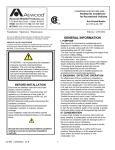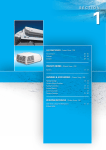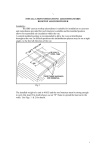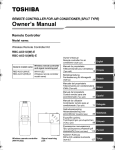Download 1800 Installation Manual
Transcript
Aircommand Australia Pty Ltd OPERATING INSTUCTIONS RHP SERIES 1800 CARAVAN AIR CONDITIONER General Hints 1. Ensure that flex coupling the caravan to the power outlet is rated at 15 amps and is only as long as is reasonably necessary. Remember that voltage drop occurs through the flex, and needlessly long flexes will reduce the output of the air conditioner, and in some cases impede its correct operation. 2. Keep the inside filter clean by occasionally removing (tug out of recess) wash in warm soapy water, and replace. 3. Maximum output is derived from the unit with the air control slide in the ‘MAX’ position, and the air deflectors fully open. 4. Strive to keep the ‘heat load’ on the caravan during summer to a minimum by: a) If possible park beneath shady trees b) Use awnings over windows c) Draw curtains and blinds over windows d) Close roof vents etc. e) Avoid use of stoves where possible during peak of day To operate on Cooling Cycle 1. Ensure power is turned on. 2. Depress ‘Cool’ button (blue). 3. Turn Black thermostat knob to mid position from ‘off’. Fan will start immediately, and if room temperature is over approximately 25°C, compressor will start, and cooling air will be apparent within 1 minute. NOTE For lower inside temperatures, turn the knob in the direction of ‘ ‘Cooler’. The minimum inside temperature the thermostat will allow I is 19-20°C. The fan will run continuously, and the thermostat will turn the compressor on and off in response to return air temperature. For nighttime use, the air volume slide may be moved to ‘MIN’ to reduce air noise. This however, does reduce the cooling capacity of the unit. To operate on Heating Cycle 1. Ensure power is turned on. 2. Depress ‘Heat’ button (red). 3. Turn Black thermostat knob to mid position from off. Fan will start immediately, and if room temperature is below approximately 24°C, compressor will start and heating air will be apparent within 1 minute. NOTE For lower inside temperature, turn knob in direction of ‘Cooler’. For h higher inside temperature, turn knob in direction of ‘Warner’. On very cold nights, the air control should be moved to ‘MIN’ to increase the temperature of the out coming air, even though the volume will be reduced. INSTALLATION General Comments 1. The Aircommand R.H.P. is designed to be installed in a 14” x 14” square hatch (355mm x 355mm). 2. The unit should be level or laying back no more than 5°. The unit must not lay forward. N.B. The plastic nose is regarded as the front of the unit and the outside coil the rear. 3. As the unit weights 55kg, reinforcing is generally necessary to strengthen the roof. 4. Electrical requirements call for a 15 amp fuse serving the unit. Any flexes should be kept to a minimum length and be rated 15 amp cable. Reinforcing 1. Internal Reinforcing: This is normally supplied ex the caravan manufacturer, and will normally consist of steel sections bolted to the roof cross members. Installation of internal reinforcing in existing caravans is usually very costly, as the roof will need to be unfastened and rolled back to allow 25 x 25 x 4 angle to be bolted to the members over which the airconditoner will lie. 2. External Reinforcing: This is the preferred method for existing vans, and should be fabricated as per figure 1. Installation Procedure 1. Select a suitable place to cut a 355 square hole or utilise an existing hatch opening of this size. 2. If cutting a new hole, ensure that it lies between existing roof members if possible. 3. Having cut the hole, the electrical cable should be installed. Depending upon electrical supply authority requirements, either: a) Install a new 15 amp weatherproof plug on the outside of the van directly in line with the hole. b) Wire across the ceiling space and connect into existing fuse or circuit breaker. Install an isolating switch approximately 150mm from the edge of the hole, and bring the cable out leaving 300mm handing out. 4. Now box up around the hole using timber minimum 25mm thick. 5. Lay down a generous bead of silicone sealant around the hole. 6. Now carefully lay the ‘H’ frame over the hole. 7. Lift unit onto roof and then place onto ‘H’ frame. Slide the rear support rail beneath tail of unit. 8. Now, from inside the van, line the unit up directly over the frame and the frame directly over the hole. 9. Wire up power supply cable to terminal box. 10. Undo elastic band from control flex and leg hand down. 11. Carefully measure the distance from the underside of the unit to the underside of the ceiling. Deduct 8mm from this measurement and proceed to trim the clear plastic extension duct to this length. (Trim the plain end and leave the flanged end). 12. Reach up and close the entry duct by pushing damper control lever backwards. (This is necessary to allow the front hold down bolts to pass behind the damper and avoid interfering with it’s operation). 13. Prepare the 4 hold down bolts by slipping on the 3 large clamp plates, and 1 short clamp plate. 14. The duct extension handle should now be slid onto the damper control rod, and it’s length adjusted such that 65mm (including thread portion) hangs below ceiling line. 15. Place the duct extension onto the upstanding flange of the base plate assembly and lift up against the ceiling, passing the damper extension arm through the slot in the base plate. 16. Referring to Figure 3, base bolts A & B can be inserted through the respective holes in base plate, and screwed into the tapped plates in the corner of the unit. Bolts C & D do not pass through assembly holes in the base plate, but when tightened up, the clamp plates secure the reinforcing angles of the plate. 17. When all bolts are engaged and lightly done up, the 2 resilient feet should be attached to the square tubular side rails of the chassis in position indicated in Figure 2. 18. Now, finally tighten the 4 hold down bolts, observing the following: a) Ensure extension duct covers the fan outlet b) Ensure that plate D is kept within the line of the side of the base plate to avoid fouling the plastic plenum 19. With a silicon gun, seal the inside of the duct extension to the underside of the unit, and likewise to the base plate. Ensure that no air leakage can occur. 20. Mate the breakway plugs on the control flex. 21. Fit plastic plenum up against base plate, and fit retaining knob. 22. Now screw in the 4 corner wood screws to pull up hard against ceiling. 23. Fit knob to threaded end of extension knob.




